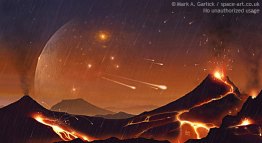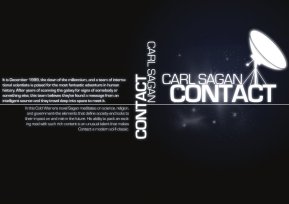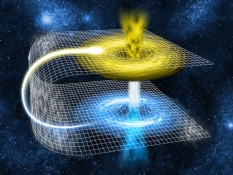
When we look back 4.6 billion years in the past, planet earth was nothing like what we see today in our everyday lives. At this time, the atmosphere contained no oxygen and was toxic to life. The planet was extremely hot and continuously collided with other things in space. However, suddenly the planet stopped gaining heat and eventually began to cool off to a solid crust. From here, water, one of the keys to life, began to appear on the surface of earth. It took approximately one billion years for the first forms of life to exist on Earth. The first forms of life on Earth were not what we would think life to be today. Microorganisms were the only forms of life until multicellular organisms suddenly arose about 580 million years ago. Over billions of years the planet we call home has been changing and growing
more diverse with each modification. Geological changes allowed for new organisms to form whereas mutations and adaptations allowed for these organisms to become more diverse and even produce completely new life forms all together. Some say it is absurd to believe that life could exist on another planet, but is it really that outrageous when our very own Earth transformed from an uninhabitable sauna to a planet where life is abundant? Carl Sagan believed that life was possible on another planet. His novel, Contact, explores the possibility of extraterrestrial life on the star, Vega. Sagan’s use of the ideas and concepts of radio astronomy, extraterrestrial life, and wormholes in this novel impacted the world in tremendous ways. Sagan not only wrote this book and many others over these interesting ideas, but also devoted his life to researching and contributing to the study of space leading to many of the facts we know about modern space.
Biography
On November 9, 1934, in Brooklyn, New York, a New York garment worker gave birth to a man that would make great contributions to the world of astronomy. Carl Sagan lived in a working-class Jewish neighborhood and attended public schools in New York and New Jersey. Carl Sagan became fascinated with science and the field of astronomy at a very young age. His interest was sparked when he attended the 1939 New York World’s Fair with his parents at the age of four. Although his parents were nowhere near wealthy, they continuously encouraged Sagan to pursue his interests in the sciences. They would buy him different books and chemistry sets in order to keep his interest alive. In 1951, Sagan graduated from Rahway High School at the age of only 16 and decided to attend the University of Chicago. During his time at the University of Chicago Sagan first received an A.B. degree with honors followed by a bachelor’s degree in Physics and then a master’s degree in Physics.

Sagan never stopped pursuing his interest in science and space and went on to obtain a Ph.D. in astronomy and astrophysics. In 1968, after being denied tenure at Harvard College as an assistant professor, Sagan accepted the position, Director of the Laboratory for Planetary Studies, and was later promoted to David Duncan Professor of Astronomy and Space Sciences at Cornell University. He maintained this position until his death in 1996.
Sagan was known for his drive to succeed and his desire to share the wonders of the sciences with others. His lifetime goals included, understanding the universe and being able to relay the information in an intriguing manner to the world. Due to his unwavering dedication to his life’s work, his first two wives were not pleased with his inability to devote time to their marriages or his children.
Research was Sagan’s life. He devoted almost all of his time to his research. His hard work and dedication allowed him to have great accomplishments and in return won him respect from his academic peers and the scientific community. Sagan was able to help in defining the disciplines of planetary science and exobiology. NASA also benefitted from his work by using his help to chart exploration of the solar system by spacecraft.
The planet Venus was of particular interest to Sagan in his early years of research. The atmosphere of Venus is mainly where he chose to focus his studies. He worked to explain and define the modern understanding of Venus’s atmosphere. Mars was another plant that caught the eye of Sagan. He believed that the seasonal changes occurring on the surface of Mars were due to wind-blown dust. The Mariner 9 and Viking spacecraft verified his belief later on.

Sagan was a key component to NASA’s success and technological advances. Sagan worked to accomplish the mission of the Viking spacecraft, which was to land this spacecraft on the surface of Mars. In 1976, the spacecraft Voyager 1 and Voyager 2 were sent on a particularly interesting mission. The mission was to transport a symbolic interstellar message beyond the Milky Way. In order to accomplish this, NASA asked for the help of Carl Sagan.
Sagan’s research and help to advance the world of science were not the only contributions he made during his lifetime. Sagan was also an avid writer and used his books to show everyone his vision of the world and science. His first book, The Cosmic Connection, was published in 1973, quickly becoming a bestseller. In the second book published by Sagan, he talks about something that intrigues many of those in the world of science, the brain and human intelligence. This book, The Dragons of Eden, won the Pulitzer Prize for general nonfiction in 1978. During the year of 1981, Sagan married his third wife, Ann Druyan, whom coauthored the only book of Sagan’s that was transformed into a film. The novel, Contact, was published in 1985 but was not made into a motion picture until August of 1997, one year after Sagan’s death.

There is no doubt that Carl Sagan was a man that will forever be remembered in history. A man capable of his brilliance, skepticism, and pure desire for knowledge has not surfaced since his passing in December of 1996. Sagan battled an extremely rare disease known as myelodysplasia for two years before he died of pneumonia. The amount of passion Sagan has, has been sought after for ages. He wanted others to feel the same excitement about space as he did. He was well known for being “the single most-recognized science missionary bringing the ideas, excitement, and adventure of space exploration to the general public” (Terzian and Bilson, 1997). Hard work, dedication, and pure passion were at the core of Carl Sagan’s life and his research and he will forever be “an icon for modern science” (Terzian and Bilson, 1997) in the eyes of Americans.
Summary
The novel, Contact, by Carl Sagan is focused around the central character Eleanor “Ellie” Arroway. The book begins by taking the reader back to some early childhood experiences of Ellie. She was very curious and not afraid to ask questions, some might even call her a skeptic. Her father passed away while she was young and her mother remarried a man named John Staughton, who Ellie does not get along with.

Ellie grows up and attends Harvard University where she studies physics and mathematics. It is here that she gains a growing interest in astronomy. After graduating, Ellie becomes the apprentice of Dr. David Drumlin, a well know radio astronomer. Continuing to follow her passion, Ellie receives her doctorate and begins work on the “Argus Project” located in New Mexico. At this site, radio astronomers use over 100 radio telescopes to monitor outer space for any signs or radio frequencies that may signal the chance of extraterrestrial life.
Ellie works on the Argus Project for a great amount of time, until one day, she believes she has received a transmission from another civilization. While monitoring the star system Vega, 26 light years away, she records a series of prime numbers being transmitted to earth. After consulting other scientists as well as public and government officials, another message is received. The second form of contact is a playback of the first time radio waves were transmitted from Earth into outer space, which was Adolf Hitler commencing the opening of the 1936 summer Olympics in Berlin, Germany.

This message was perceived to be a sign that extraterrestrials had received our radio transmissions and were responding to us. However, after closer analysis, there was an encrypted message found in the transmission. After finding the code to decipher the encryption, a blue print that reveals the instructions to building some sort of machine.
It was not entirely known what the machine was supposed to be used for. After long debates and much controversy, the United States and Russia each began building the machine. Due to technical difficulties the Russians are unable to complete the machine leaving the United States to finish out the project. Originally, Ellie is not chosen to be a passenger in the machine. As the United States prepares to test their machine, mechanical error arises and destroys the machine, killing the previously selected 5 passengers along with it. Ellie, with the help of her billionaire friend S. R. Hadden, is chosen to be one of the passengers on a third machine that was secretly built near Hokkaido Japan by Hadden.

The machine is a success and Ellie along with her four crewmates traveled through what they think is a black hole, but is actually a wormhole. The only difference lays in the fact that black holes have no end, whereas wormholes have a beginning and an end. Along the way, they view many other star systems and arrive at what they believe to be the star system Vega, where the original message originated. They arrive on a sandy beach near an ocean with an atmosphere that appears to be similar to that of Earth’s. The crewmembers eventually get separated on the beach and Ellie is greeted by what she believes to be her deceased father. It is later revealed to Ellie that this form of extraterrestrial life took on the appearance of her father in order to keep from frightening her. It is explained to Ellie that it was a long lost species that created the wormholes for traveling through space. Other crewmembers have similar experiences and are met by past family members. Ellie, who is a fierce opponent of religion throughout the book, eventually comes to accept the possibility that there might be a supreme being or creator of the universe. Upon returning to Earth, Ellie and her colleagues believe that they have video evidence of their travels. However, somehow the video has been erased and what seemed like many long hours of travel was really no time on Earth. After learning that Hadden has died and there is no evidence to support the travelers, government officials accuse them of conspiracy. After finally returning to her normal life, Ellie uses information given to her while on her mission to fuel her new research desire surrounding π.
The novel ends by describing Ellie’s encounter with John Staughton after the death of her mother. Her stepfather shows up with a note and as she opens it, she realizes her mother was the author of the note. In the note, her mother confesses that the man she believed to be her biological father was not her dad. Ellie’s biological father was really John Staughton, the man Ellie had despised since he married her mother.
Science: The Wormhole
In the novel, Contact, Carl Sagan describes an astonishing and new idea when Elanor travels to Vega by means of a wormhole. Wormholes are considered to bend space and time allowing the connection of two distant regions in the universe. While wormholes or Einstein-Rosen bridges are still only theoretical, they provide the world with something to look forward to in the future.

Karl Schwarzschild is known for coming up with the concept that a point mass curves spacetime around it. This was his idea of general relativity. It contains two singularities, where “mathematical quantities become infinite” (Lindley, 2005). Albert Einstein and his associate, Nathan Rosen, were not fond of these singularities and were determined to get rid of them.

In 1935, the two scientists came up with a solution that eliminated the Schwarzschild singularities. Nevertheless, this posed a new solution. Jim Al-Khalili discusses the discoveries of Einstein and Rosen in his book Black Holes, Wormholes and Time Machines, Second Edition. Al-Khalili writes, “They showed that the singularity became a bridge connecting our universe with… a parallel universe” (Al-Khalili, 2012). Sadly, Einstein did not believe that such a thing could actually exist and wanted only to explore other alternatives to Schwarzschild’s equation.
There have been many works of literature that use the idea of connecting two different worlds. Carl Sagan is one of the many authors that use the Einstein-Rosen bridge to break spacetime. Tragically, many works of literature wrongfully convey the travel to parallel universes and time travel. Even if we some day discover a real wormhole, there will be no way to practically use it as a means of transportation to a different universe.
Here are some relevant links to more information on black holes and wormholes:
National Geographic: Travel to Another Universe
Black holes and Wormholes Explained
Science: The Search for Extraterrestrial Intelligence

The thought of life on another planet has become an extremely well known and controversial topic over the decades. Religious beliefs contradict the idea of extraterrestrial life and the idea that life could exist on another planet. However, this doesn’t stop some from searching for these forms of life elsewhere in the universe. Sagan was one of these men that believed and worked to find these life forms. His novel, Contact, displays his passion to search, find, and contact other life in the universe. Sagan worked closely with other scientists who also believed the planet we call home was not the only plant forms of life called home which greatly influenced his writing of this novel.
The search for extraterrestrial life was not popular until around the year 1960 when three scientists; Frank Drank, Giuseppe Cocconi, and Philip Morrison began publicizing the search for life. NASA was even a contributor to research during the early years of SETI, the Search for ExtraTerrestrial Intelligence. Eventually setting up an entire program dedicated to the cause. There are thousands of answers being asked by scientists and skeptics alike, but very few answers are being received.

Frank Drake worked with a few other scientists in the late 60s and early 70s, including Carl Sagan, in order to find a formula in an attempt to determine the number of planets that harbor the potential for life. This equation is now known as the Drake equation and has found that there are over a billion planets in the universe with this potential.
One problem that arises when studying extraterrestrial life is the gap in understanding when molecules actually become alive. In an article written by Martin Dominik and John C. Zarnecki, an important question is addressed that most people do not consider. The article reads,
We readily accept that the concepts of physics and chemistry apply throughout the cosmos and are valid for all time, but should this not make us wonder where biology is universal as well, and not just a special feature that only applies to planet Earth? (Dominik, 2011)
Is it really so outrageous to believe that biology could apply to other places in the universe as well? In the book Conversations with Carl Sagan, Sagan is recorded saying, “I believe that the search for life is of such extreme importance to science, philosophy, and to our ideas about ourselves that every time we go to a new place, we have to ask ourselves seriously about whether there’s life there” (Meredith, 1979). Although this idea is shared by many in the search for extraterrestrial life, research has yet to provide us with any relevant evidence proving the existence of life on other planets.
Science: Radio Astronomy
There is no question that Carl Sagan’s book, Contact, was influenced by space exploration and the technological breakthroughs that were being made during the time in which he was writing this novel. Sagan used radio astronomy in his early career to make one of his most notable discoveries. Using the plant Venus’s radio emissions, Sagan was able to find the cause of these radio emissions was due to the extreme conditions of the planet’s atmosphere. Sagan also writes about the use of the radio telescope in order to make contact with extraterrestrial life in his book, Contact. However, none of this would have been possible without the discovery and the main contributors to the field of radio astronomy.
Before the early 1930s, not much was known about radio waves. The only studies or research performed was in the 1890s when scientist tried to detect radio waves from the Sun. The results were inconclusive due to primitive equipment. From then on radio waves were thought to only exist on Earth or were undetectable in the solar system. In 1932, a man named Karl Janksy proposed an idea that was thought to be ridiculous at the time by the rest of the world. While working as a radio engineer assigned to detect the source of radio static or noise that would block wave transmission for the Bell Telephone Laboratories Janksy discovered an interesting cause for the communication static. He explained that this static was caused by waves that were being emitted beyond the solar system, more commonly known as extraterrestrial radio waves.

Most astronomers of the time paid no attention to Janksy’s discovery. Nevertheless, one man, Grote Reber, believed in Janksy’s work. Lisa Yount’s Modern Astronomy: Expanding the Universe recalls Reber’s account of the findings as, “a fundamental and very important discovery” (Yount, 2006). The year of 1937 was eventful for Reber. With help from friends and family Reber was able to manufacture the first radio telescope in his backyard. Weighing approximately two tons with a parabola shaped iron mirror measuring nine meters in diameter, the telescope was capable of transforming the electric signals into electric signals. The electric signals produced were then recorded on paper. Reber was able to confirm the radiation from the Milky Way that Janksy had first discovered.

After committing his work to radio waves and radio telescopes, Reber produced the first radio maps of the sky in the early 1940s and found the center of the Milky Way was the source of some of the strongest signals. In 1944 Reber finally published a complete radio map of the sky after working for three years in hopes of worldwide recognition. Sadly, the world’s engagement in World War II masked his hopes of obtaining the world’s recognition. Luckily, one of his articles caught the eye of Jan Oort, the director of the Netherlands’ Leiden Observatory. Oort believed that the fixed lines of the electromagnetic spectrum created by specific wavelengths of radio waves could be moved from their present position by the Doppler effect. This would allow astronomers to “measure the distance and movement of objects that did not give off light such as gas clouds themselves” (Yount, 2006).
One of Oort’s students predicted that, “atoms of hydrogen… would give off radio waves 21 centimeters (about 8 in.) long” (Yount, 2006). After this prediction was proved to be correct in 1951, these hydrogen emissions were used to prove that the Milky Way galaxy was indeed a spiral like shape. Contrary to popular belief, radio telescopes do not actually carry sound, but instead radio waves are processed and have the possibility of being converted into images on a computer or TV screen.
Without the brilliant and courageous scientists, our ideas of modern space and time would be greatly altered. The use of radio astronomy has led to amazing discoveries in the past few decades. Pulsars, quasars, and many events that occur in space are just a few of these discoveries.
The study of space is a very difficult yet intriguing field. The beauty of this unknown is slowly catching the eyes of many astronomers like Carl Sagan. Sagan worked diligently in an attempt to show the world the marvels of the universe. This is especially evident in his writings. He not only wrote about the things discussed in this novel, but also spent his life researching them.
Conclusion
The book, Contact, is believed to give an insight into some of Sagan’s personal ideas about various realms of space and science. A book review published by Jeff Clark in 1985 reads, “the ideas are stimulating, and Contact makes for entertaining reading” (Clark, 1985). This was always a goal of Sagan, to inform the world of the entertaining and awe inspiring aspects that our universe has to offer. The sciences and scientists that contributed to the ideas of contained in the book deal with whether or not further research in some fields like extraterrestrial life should be continued. Carl Sagan was a brilliant scientist, idealist, and author that forever altered the world of astronomy and other aspects of science through his devotion to research and his works of literature.
Listed below are a few more relevant links including one to a TV series that Sagan helped write:
Works Cited
Works Cited
Al-Khalili, Jim. “Wormholes.” Black Holes, Wormholes, and Time Machines. Boca Raton, FL: Taylor & Francis, 2012. 135-38. Google Books. Web. 30 June 2014. <http://books.google.com/books?id=v__ukMwx4IwC&printsec=frontcover&dq=black+holes,+wormholes+and+time+machines&hl=en&sa=X&ei=Ll2zU9HcHNCKqAb_3oHgDw&ved=0CCQQ6AEwAQ#v=onepage&q=black%20holes%2C%20wormholes%20and%20time%20machines&f=false>.
Clark, Jeff. “Contact.” Library Journal 110.20 (1985): 128. Academic Search Premier. Web. 1 July 2014.
Dominik, M., and J. C. Zarnecki. “The Detection of Extra-terrestrial Life and the Consequences for Science and Society.” Philosophical Transactions of the Royal Society A: Mathematical, Physical and Engineering Sciences 369.1936 (2011): 499-507. Highwire Press Royal Society. Web. 28 June 2014. <http://rsta.royalsocietypublishing.org/content/369/1936/499>.
Elbers, Astrid. “The Establishment of the New Field of Radio Astronomy in the Post-War Netherlands: A Search for Allies and Funding.” Centaurus 54.4 (2012): 265-85. Web. 26 June 2014.
Jones, Barry O. Dictionary of World Biography. Melbourne, VIC: Information Australia, 1994. Print.
Lindley, David. “The Birth of Wormholes.” Focus 15 (2005). American Physical Society. Web. 30 June 2014. <http://physics.aps.org/story/v15/st11>.
Overbye, Dennis. “Please Call Earth. We Still Haven’t Found You.” The New York Times 2 Mar. 2008: WK4. ProQuest Historical Newspapers. Web. 29 June 2014. <http://search.proquest.com/docview/897744707?accountid=12964>.
Sagan, Carl, and Tom Head. Conversations with Carl Sagan. Jackson: U of Mississippi, 2006. Google Books. Web. 29 June 2014. <http://books.google.com/books?id=gJ1rDj2nR3EC&pg=PA51&dq=carl+sagan+extraterrestrial+life&hl=en&sa=X&ei=RTezU92FCoySqAbgkYD4CQ&ved=0CCQQ6AEwAQ#v=onepage&q=carl%20sagan%20extraterrestrial%20life&f=false>.
Sagan, Carl. Contact: A Novel. New York: Simon and Schuster, 1985. Print.
Smith, Robert W. “Collaboration, Competition, and the Early History of Radio Astronomy.” Metascience (2014) 23 (2013). Ebscohost. Web. 28 June 2014.
Spangenburg, Ray, and Diane Moser. Carl Sagan: A Biography. Westport, CT: Greenwood Pub. Group, 2004. Print.
Terzian, Yervant, and Elizabeth M. Bilson. Carl Sagan’s Universe. Cambridge, U.K.: Cambridge UP, 1997. Print.
Yount, Lisa. Modern Astronomy: Expanding the Universe. New York: Chelsea House, 2006. Print.

